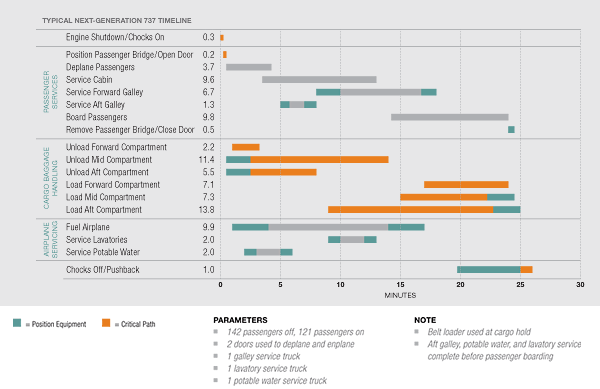
The Boeing team uses a variety of criteria during the study, including the International Air Transportation Association’s Airport Handling Manual, actual airline observations, Boeing-recommended practices and procedures, accepted industry standards, and knowledge of ramp handling operations and GSE requirements.
At the conclusion of a ramp/terminal operation analysis, the Boeing team verbally debriefs the airline’s management on the significant findings. The airline also receives a written report approximately 30 days after the on-site evaluation. Reports typically range from 50 to 80 pages and provide detailed findings, observed and proposed timelines, and recommendations (see fig. 2). Airline findings are strictly treated as proprietary information and not shared with other airlines.
DETAILED RECOMMENDATIONS TO IMPROVE TURN-TIME EFFICIENCY
Figure 2
Each turn-time study includes a detailed written report with specific recommendations, such as this flow chart, on how an airline can improve turn-times.
BENEFITS OF TURN-TIME STUDIES
Turn-time studies provide operators with detailed recommendations on how individual tasks can be improved and how multiple tasks can be coordinated to permit optimum ramp/terminal operations and improve airplane utilization. These studies enable airlines to compare their methods and performance to that of other operators, obtain an independent review of operations and processes, and identify problems and prioritize solutions. Airlines can realize a number of benefits from turn‑time studies, including:
- Efficient, repeatable, and safe turnaround operation on the ramp and inside the airport terminal.
- Possibility of additional revenue and additional flights per day.
- Reduced “ramp rash” through safety awareness and recurrent training.
- Safer ramp/terminal infrastructure, equipment, and operations.
- Fuel savings through reduced auxiliary power unit usage.
- Reduced airplane scheduling conflicts on the ground and at the gates.
- Reduced gate time for airplanes during turnaround operations.
- Maximized gate usage during peak operational times.
- Improved passenger satisfaction.
- Proper use and availability of GSE.
- Better utilization of ramp personnel.
- Increased management awareness of ramp and terminal operations.
As outlined in the preceding article, “Economic Impact of Airplane Turn-Times,” airplane turn-time studies can also help an airline keep airplanes earning revenue during a greater portion of their duty cycle. The time recovered may even allow an additional flight at the end of the day. In one actual case, Boeing helped an airline increase its number of quick turns (a turn accomplished in 30 minutes or less in most stations) by 33 percent.
SUMMARY
A Boeing team is available on-site to assist operators in optimizing their airplane turn-times by using analytical methods and standards to improve individual tasks and coordinate multiple events on the ramp. Boeing can perform this fee-based turn-time analysis for all models of Boeing airplanes. These studies incorporate airline maintenance, airline policy, government regulatory requirements, and GSE availability. At the conclusion, Boeing will provide the operator with a detailed written report documenting the findings and recommendations as well as an implementation plan to reduce overall turn-times.
For more information, please contact Troy Barnett at troy.a.barnett@boeing.com or view his Web site at http://www.boeing.com/commercial/ams/mss/brochures/turntime.html


